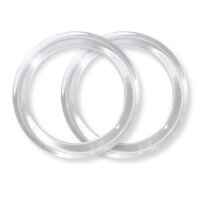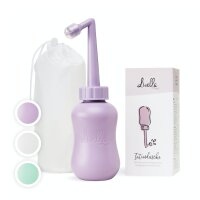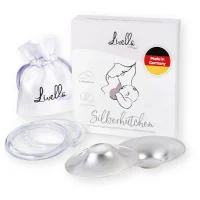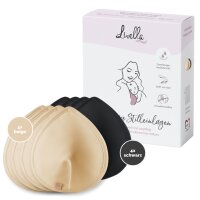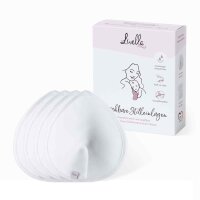The fear of not having enough breast milk is very common among breastfeeding mothers. Mature milk is a lot thinner than the initial colostrum, which often leads to concerns about it not being sufficient to provide the baby with enough energy and nutrients for a healthy development.
An exclusively breastfed baby has a daily milk intake of between 570 ml and 900 ml (this peak intake refers to babies between 1 and 6 months of age). The problem with breastfeeding, however, is that it’s impossible to measure how much milk the baby actually drinks while attached to the breast.
So, how to know if low milk supply is really an issue? What are the signs of low milk supply? Why is it that some mothers don’t make enough breast milk? And what to do to increase milk supply?
Table of Contents
Is low milk supply really a problem?
Signs of low milk supply
Causes of low milk supply
Low milk supply: Tips for boosting your milk production
Supplementing low milk supply with formula
A final word on low milk supply
Is low milk supply really a problem?
Sooner or later, every breastfeeding mum worries that she might not have enough milk for her baby. After all, breast milk appears to be quite thin, which is why many women are concerned that it doesn’t provide enough nutrition for their fast-growing baby.
In fact, roughly 35% of all women that wean early do so because they think their milk supply is too low. Very often, perceived insufficient milk (short: PIM) is a result of a misinterpretation of certain behavioural patterns such as a frequent desire to breastfeed. In the majority of cases, however, there is no real reason for the mother to believe that her milk supply is insufficient.
As long as the baby shows a healthy development, gains weight constantly (150 grams or more per week on average during the first three months of life) and has 5-6 wet nappies a day, there’s usually no need to worry. Not to forget that the World Health Organisation (WHO) recommends exclusive breastfeeding for the first six months of life.

Signs of low milk supply
Given that concerns about not having enough breast milk are usually unfounded, it’s all the more important to know when there really is a problem with milk production. The most common signs of low milk supply include:
- Baby is having difficulties to grasp the breast correctly, which can lead to sore nipples
- Weight gain is slower than usual (i. e. below the average of 155-240 grams per week)
- Baby shows increased sleepiness or even lethargy
- Breastfeeding sessions are unusually long or short
- Baby is crying excessively
- Baby’s urine smells very strong and the number of wet nappies per day is lower than 5
- Baby shows signs of dehydration, such as a dry mouth or sunken eyes
Good to know: Just because your baby wants to feed very often, this doesn't mean he or she is not getting enough milk. Especially in the first few days, your baby’s desire to feed frequently is down to the fact that his or her stomach is still very small and can only take small amounts of milk during each feed.
Causes of low milk supply
If it really is the case that you have too little breast milk, the first step towards solving the problem is to determine what the underlying cause is. Low milk supply can have many different causes, including:
- Bad breastfeeding management and infrequent feeding
- Inhibited let-down reflex
- Weak suck or bad sucking technique due to the use of dummies or bottlefeeding
- Bad breastfeeding latch that prevents the breast from being drained properly
- Excessive stress that prevents the release of the bonding hormone oxytocin that helps let-down
- Fatigue
- Prolonged separation of mother and baby after birth
- Certain types of medication
- Smoking
- Topping up breast milk with formula without actual need
There are also a number of medical reasons for low milk supply, such as:
- Hormonal disorder or diseases affecting the hormonal system
- Thyroid problems
- Retained placenta
- Very severe postpartum blood loss
- Breast surgery or recent breast condition such as mastitis
However, it should be said that cases where low milk supply is caused by a medical condition are fairly rare. So, before you jump to conclusions and stop breastfeeding prematurely, you should seek advice from a healthcare professional such as your midwife or a lactation consultant.
Low milk supply: Tips for boosting your milk production
If low milk supply is caused by bad breastfeeding management or anything else that is not health-related, you can try different techniques to increase milk production. For example, you can try to:
- Increase breastfeeding frequency: Frequent breastfeeding signals your body that more milk is needed and hence helps increase milk supply. The general recommendation is to breastfeed at least 8 times within 24 hours—ideally even 10 to 12 times.
- Apply relaxation techniques: Tensing up during breastfeeding can inhibit your let-down reflex, which prevents your little one from emptying your breast properly. Relaxation exercises can help.
- Change your diet: A healthy and balanced breastfeeding diet is a prerequisite for counteracting low milk supply. After all, the body needs more energy than usual to make milk.
- Drink lactation tea: Breastfeeding tea contains various herbs and other ingredients that are believed to increase milk production. The tea can either be bought individually or as part of a breastfeeding set along with other useful breastfeeding accessories such as silver nursing cups.
- Increase skin-to-skin contact: Skin-to-skin contact not only promotes maternal bonding, but it is also important for the production and release of hormones which regulate let-down and milk supply.
- Express breast milk by hand or with a breast pump: Milk supply follows the principle of supply and demand. This means that signalling the body that more milk is needed will ultimately lead to the body producing more of it.
- Get a good breastfeeding latch: Getting a good breastfeeding latch is crucial for mothers who struggle with low milk supply. It’s only when your baby is properly attached to your breast that he or she will be able to drain your breast properly.
- Use warmth to improve milk flow: Applying warm compresses or breast gel pads to the breasts can help with weak let-down and promote better milk flow.
- Take galactogogues like domperidone: The term galactagogues refers to both herbs and prescription medication that reverse low milk supply. The most often prescribed medication for increasing breast milk is domperidone. However, you should consult with a doctor first to assess whether medication is really necessary.

Supplementing low milk supply with formula
In cases of true low milk supply, supplementing breastfeeding with formula becomes necessary. Giving your baby formula while keeping up breastfeeding is known as mixed feeding. Balancing breastfeeding and bottlefeeding can be challenging, but with the professional support of a midwife or lactation consultant, you should be able to find a mix that works well for you and your baby.
Different types of formula
The first thing many mothers notice when they want to start supplementing their low milk supply is that there are different types of infant formula:
- Infant formula which is suitable for babies from birth
- Follow-on formula which is intended for feeding after 6 months of age
- Formula for children over the age of 1 year
Good to know: In contrast to infant formula and follow-on formula, milk supplements that are marketed for children over 1 year of age are not regulated when it comes to composition, labelling or marketing.
Which formula to supplement low milk supply?
Just because there are different types of formula that are marketed for different stages of your baby’s development, this doesn’t mean that you have to switch between different formulas. In fact, infant formula that is suitable for newborn babies can be fed until the baby reaches 1 year of age.
Moving your baby on to follow-on formula at 6 months of age is generally not recommended since these products are costlier without providing any additional health-related benefits. Instead, you should get your baby started on solids to cover all your baby’s nutritional needs.
How to give extra milk to supplement low milk supply?
There are different ways to feed a baby formula to make up for low milk supply. Bottlefeeding is not recommended because the use of a bottle could have a negative impact on the baby’s latch. Instead, you should opt for one of the following feeding techniques:
- Using a nursing supplementer: A nursing supplementer is a lactation aid that is used to feed your baby extra milk while he or she is breastfeeding. The extra milk is stored in a little container from where it is transported into your baby’s mouth via a tube.
- Cup-feeding: As the name suggests, cup-feeding involves the use of a small cup with which you feed your baby the formula supplement.
- Spoon-feeding: Spoon-feeding works well in the first few days after birth when your baby only needs small amounts of milk. As soon as your baby’s milk intake increases, however, using a tea spoon to give extra milk isn’t effective enough.
A final word on low milk supply
Many breastfeeding mums are concerned about their milk supply. So if you’re worried that you may not have enough breast milk for your baby, you’re not alone. Milk production can be slow in the beginning and your body may take some time to produce enough milk to meet your baby’s needs. But with good breastfeeding management, additional pumping and a proper breastfeeding latch, milk supply should steadily increase.
Remember that true low milk supply caused by a medical or anatomical condition is very rare. To put your mind at ease, you can check for signs of low milk supply such as sleepiness, lethargy, slow weight gain or excessive crying. If your baby develops well, gains weight and looks happy and healthy, then there’s nothing to worry about.
If, despite taking action to increase your breast milk, your milk supply is still low, you can talk to your midwife or a lactation consultant about supplementing breastfeeding with infant formula. They can also give you advice on which formula to use and how to get into a good mixed-feeding routine. Don’t forget that low milk supply doesn’t mean you have to stop breastfeeding.
References
- Is my baby getting enough milk? - La Leche League International (llli.org)
- How to increase your milk supply - La Leche League GB
- Low milk supply | The Royal Women's Hospital (thewomens.org.au)
- Maternal Perceptions of Insufficient Milk Supply in Breastfeeding - PMC (nih.gov)
- Infant and young child feeding (who.int)
- https://www.chop.edu/pages/low-milk-supply
- How to increase milk supply | Livella.de
- Using donor milk and formula to support breastfeeding - La Leche League GB
- Nursing Supplementers - La Leche League GB
- Infant milks for parents & carers — First Steps Nutrition Trust
- Relactation and Induced Lactation - La Leche League GB
- Mixed feeding | Australian Breastfeeding Association




